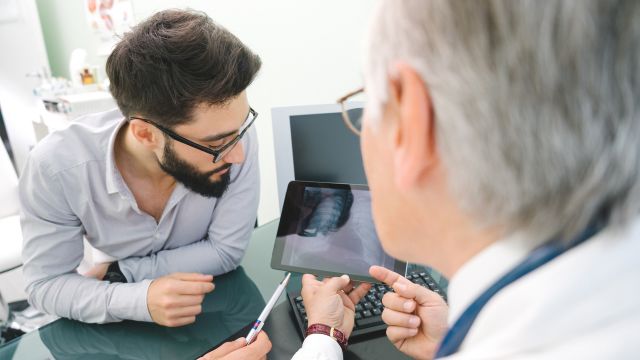Lung cancer is a certified killer, and it’s much more common than people realize. In fact, more than one-quarter of cancer deaths are from lung cancer. “Lung cancer is the most common cancer worldwide,” says cardiac and thoracic surgeon Matthew Arneson, MD, of Wesley Medical Center in Wichita, Kansas.
About 90 percent of lung cancer cases are due to smoking, and the five-year survival rate is low. Just over half of people with lung cancer survive past five years if their cancer hadn’t spread by the time it was found. That number drops to about one in five if the cancer had already spread before it was found.
“Only about 15 percent of people get it diagnosed at an early stage,” adds Dr. Arneson. “Our goal is to increase that 15 percent so we can treat them earlier and have a better cure rate.” Lung cancer screening may be the answer.
Should I be screened?
According to guidelines issued by the U.S. Preventive Services Task Force (USPSTF) in March 2021, you should get screened annually for lung cancer if you’re between the ages of 50 and 80 and you:
- Smoke cigarettes currently or have only quit within the past 15 years
- Have a 20 pack-year smoking history
What’s a “pack-year”? It’s a measure of how much a person has smoked in their lifetime, calculated by taking the number of packs they smoke per day times the number of years they smoked. So, if you’ve smoked one pack a day for 20 years, or two packs a day for 10 years, you fit the criteria.
A low-dose CT scan is the only reliable screening method for lung cancer, says Arneson. Other tests that have been used in the past include sputum tests, which look for cancer cells, and chest X-rays. A 2012 study compared CT scans and X-rays, and CT scans came out the clear winner.
“CT scans are a lot more specific,” according to Arneson. “With a chest X-ray, you often can’t see nodules that are close to the heart or other organs. The other thing is, some nodules are very small and the X-ray is not as sensitive in finding small nodules. The smaller the nodule, the more likely it is to be cured.”
Benefits and risks
The benefits of lung cancer screening are clear: You’re more likely to have small growths detected, so you can start the treatment process earlier than if you were to wait for symptoms to appear. Symptoms of lung cancer include coughing up blood, pain, shortness of breath and weight loss.
“Unfortunately, when symptoms arise, it means the cancer has advanced,” says Arneson.
According to Arneson, the risks of screening are few. It’s called a “low-dose” CT scan for a reason. Yes, you are exposed to radiation with each screening, somewhere in the range of 0.65 to 2.36 millisieverts (mSv) for each scan, according to the USPSTF. But to put that into context, the background radiation an average American is exposed to simply by walking around for a year is more than that—approximately 2.4 mSv.
One downside to bear in mind, says Arneson, is the risk of a false positive. This is a case where something shows up on the scan that requires further tests that actually turns out not to be cancer. That risk is all too real: 97.5 percent of all positive screening results do not lead to a cancer diagnosis, according to a January 2017 study in JAMA Internal Medicine.
“That’s why before anyone gets a CT scan, there’s a conversation about options and the risks of false positives and negatives,” says Arneson. “No test is 100 percent accurate.”
Talk to your healthcare provider if you’re a current or former smoker between ages 50 and 80 to see if screening is right for you.







